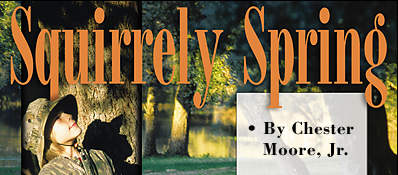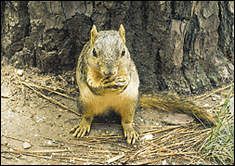
Although participation has dwindled in recent years, the East Texas spring squirrel season remains a super-productive option for Pineywoods hunters.
Page 2
Even if they don't have access to prime squirrel habitat on private land, East Texas squirrel hunters can find ample opportunities on public land. Most of the national forest areas and the wildlife management areas managed by the TPWD in East Texas offer quality spring squirrel hunting.
TPWD officials manage more than 800,000 acres in East Texas, available for squirrel hunting through the Public Hunting Lands Program. For a $40 Annual Public Hunting Permit, which may be purchased wherever hunting licenses are sold, hunters can access these areas during designated seasons.
Youngsters under 17 years of age are not required to purchase the permit, but must have a $6 Special Resident Hunting License and be accompanied by a permitted adult. When you purchase this license you get a book full of maps detailing all of the TPWD-managed properties and what species are available there.
"There's one important thing we would like to get across," Wolf continues. "Squirrel hunting in East Texas is one of those situations in which there is plenty of access despite overall declining habitat. With the amount of public hunting land that has good squirrel numbers on it, coupled with private hunting clubs, there are still places to squirrel hunt. But," he adds, "the tradition seems to fade a little more every year."

Adequate habitat is imperative to squirrel populations. TPWD personnel believe that this year's continued high level of mast production should provide spring squirrel hunters with plenty of game.
|
Wolf notes that squirrel hunting continues to be a tradition in the Pineywoods region, as it is in many parts of the South.
But this activity is quickly eroding, a victim of everything from changes in demographics and psychographics to hunting practices.
The number of squirrel hunters in Texas has dropped from more than a quarter-million in 1980 to about 100,000 today. And that number is almost sure to continue spiraling downward if current trends aren't bucked.
According to Wolf, this rapid decline has to do with several important biological and social factors.
"Changes in land use have really hurt some prime habitat, and as a result some people decided to give up. Also," he notes, "hunter attitudes have changed as well. Twenty years ago squirrels were probably the most important game animal in the Pineywoods. Now, that honor goes to the white-tailed deer.
"We're finding more and more hunting clubs that do not allow squirrel hunting because of conflicts with deer hunters, and we feel this (the spring season) is a good way to work around that problem," he adds.
Wolf says spring squirrel season is one way TPWD officials are attempting to work around conflicts with deer hunting and other outdoor pursuits.
"Spring squirrel season has no big biological impact on squirrels," he concludes. "It's just designed to allow hunters more access to this often-underutilized resource. If we can keep the tradition of squirrel hunting alive, many of us would be thrilled."
Squirrel hunting is one of those pursuits that doesn't come with much pressure. Squirrels are still abundant and relatively easy to hunt, so they make an excellent quarry for first-time hunters.
Unlike hunting many other game species, which require a higher level of patience and skill, squirrel hunting success can be achieved at a casual pace. That's what makes it such an ideal pursuit for young people and newcomers to hunting.
It's a great way to pass along the hunting tradition. And now is the time to do it.
(Editor's Note: Aside from the special Pineywoods spring season, some Texas counties in fact allow for a year-round squirrel season. For specifics, check your TPWD regulations book (available at most sporting goods stores) or call the department at 1-800-792-1112.)
# # # #
page 1 / page 2
| 
